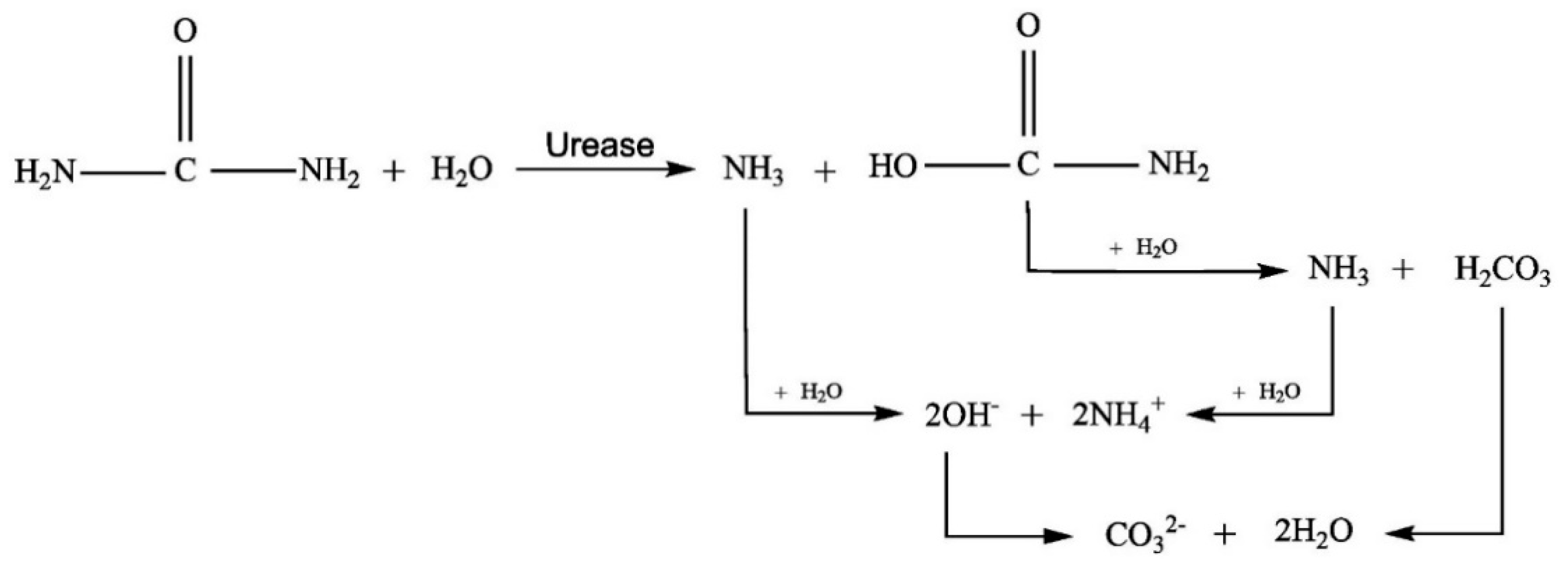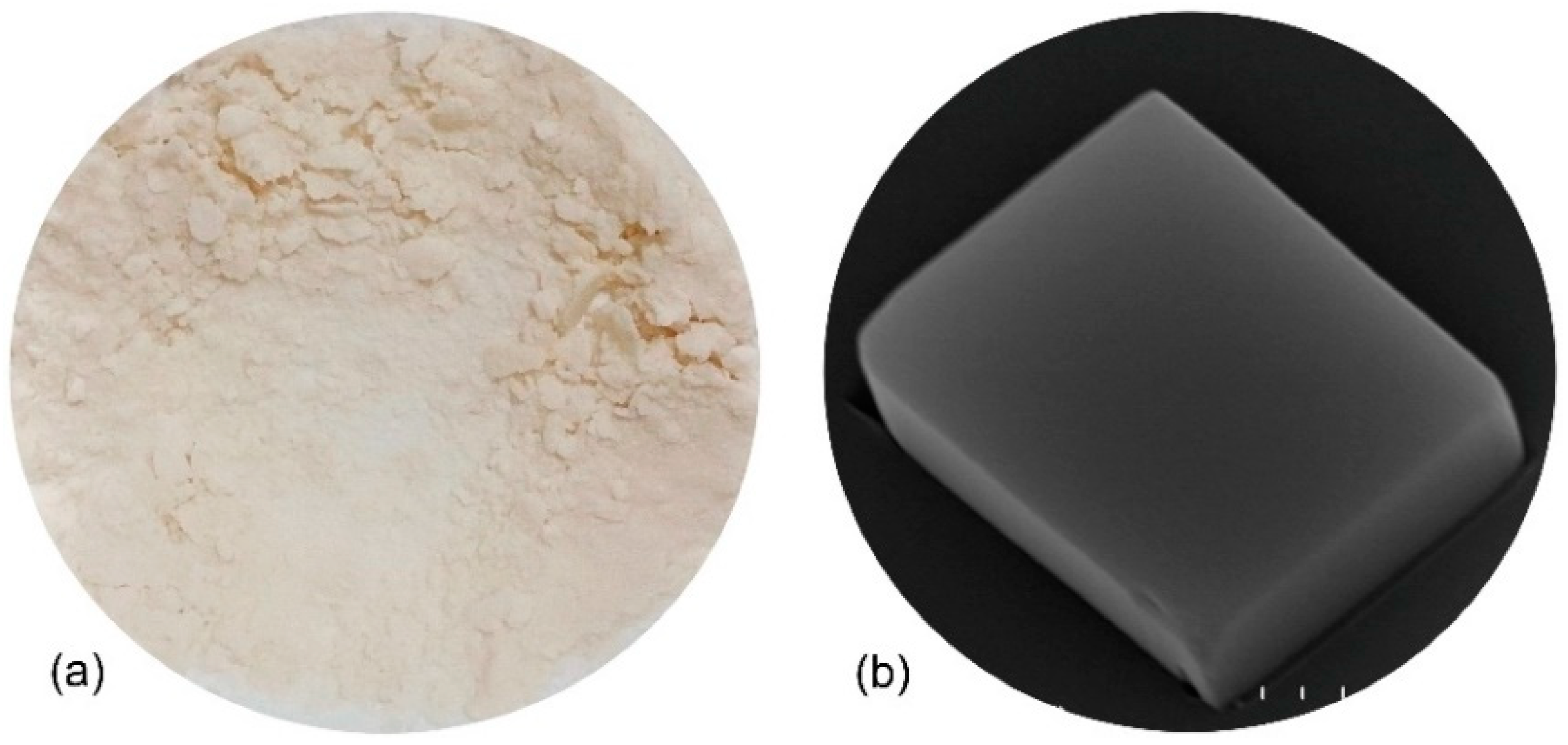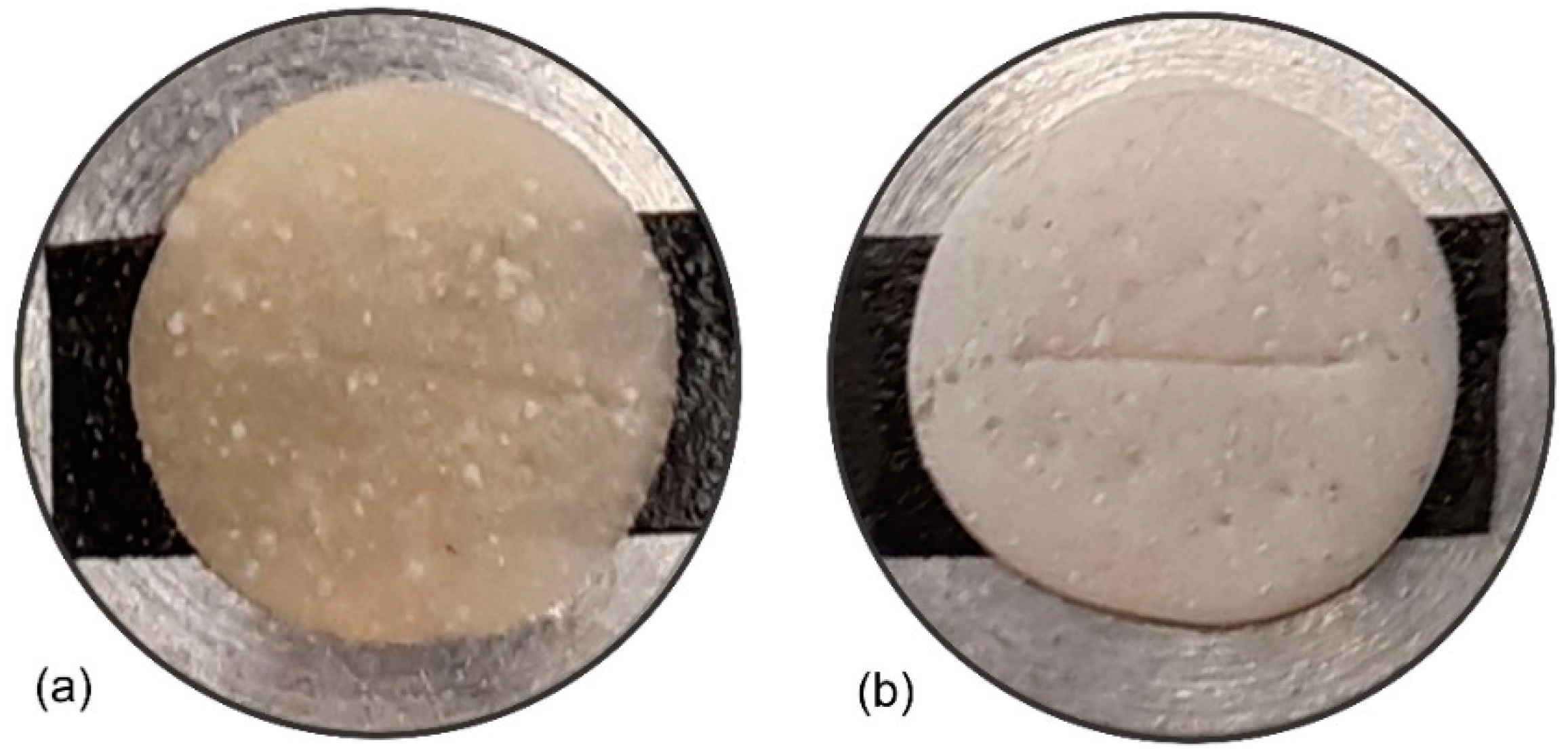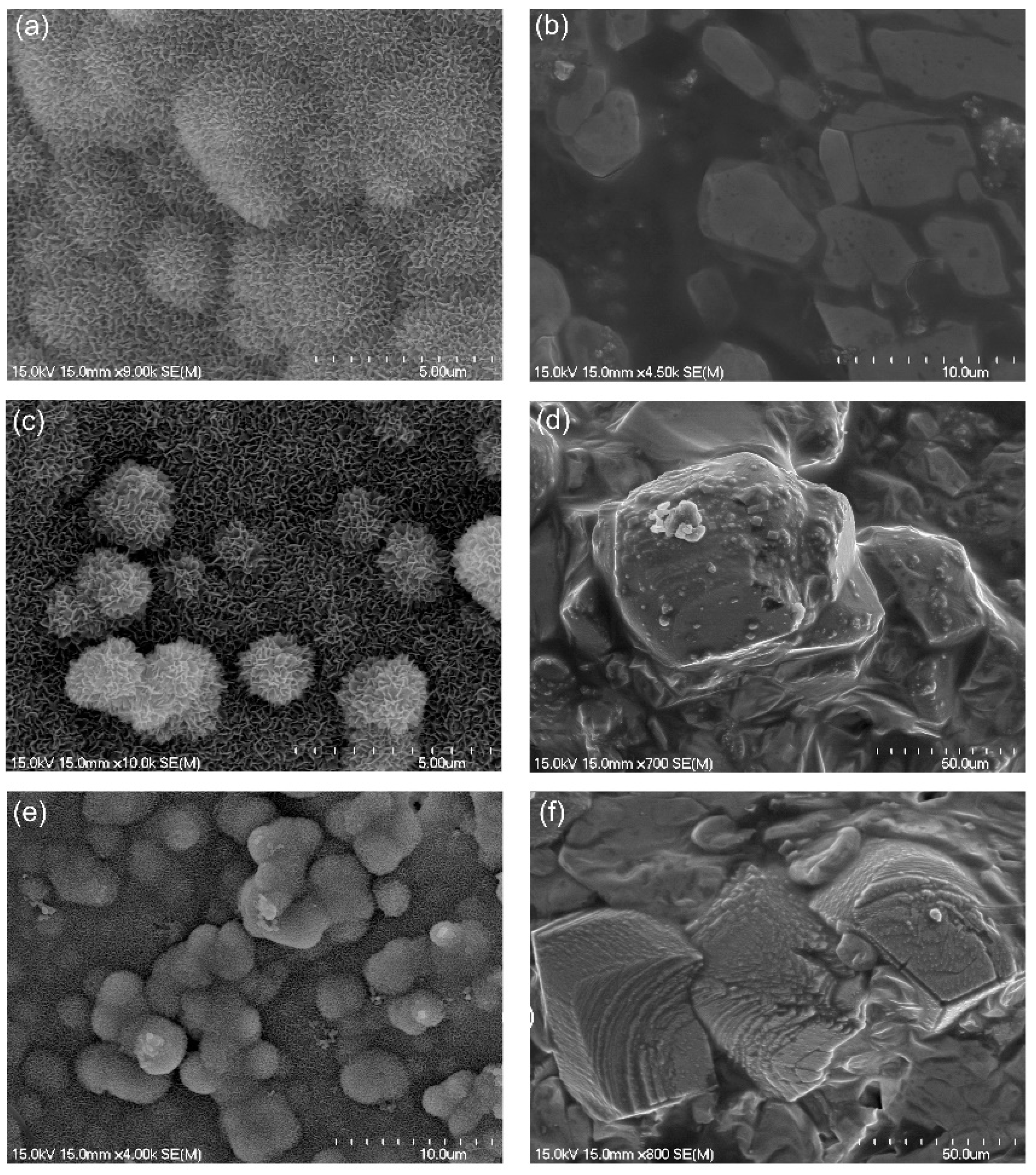Development of an Innovative Urease-Aided Self-Healing Dental Composite
Abstract
1. Introduction
2. Results
2.1. Viability of Producing CaCO3 by Enzyme in Liquid Media
2.2. Possibility of Producing CaCO3 in Dental Composite Matrix
2.3. Behaviour of Self-Healing Dental Composite in Saliva
3. Discussion
4. Materials and Methods
4.1. Materials
4.2. Self-Healing Composite Preparation
4.3. Microscopic Observation Using Optical and Scanning Electron Microscopy
5. Conclusions
Author Contributions
Funding
Conflicts of Interest
References
- Xu, X.; Ling, L.; Wang, R.; Burgess, J.O. Formulation and characterization of a novel fluoride-releasing dental composite. Dent. Mater. 2006, 22, 1014–1023. [Google Scholar] [CrossRef] [PubMed]
- Busato, A.; Loguercio, A.D.; Reis, A.; Carrilho, M.R. Clinical evaluation of posterior composite restorations: 6-year results. Am. J. Dent. 2001, 14, 304–308. [Google Scholar] [PubMed]
- Lopes, L.; Cefaly, D.; Franco, E.B.; Mondelli, R.F.L.; Lauris, J.R.P.; Navarro, M.F. Clinical evaluation of two packable posterior composite resins: Two-year results. Clin. Oral. Investig. 2003, 7, 123–128. [Google Scholar] [CrossRef] [PubMed]
- Oberländer, H.; Hiller, K.-A.; Thonemann, B.; Schmalz, G. Clinical evaluation of packable composite resins in Class-II restorations. Clin. Oral Investig. 2001, 5, 102–107. [Google Scholar] [CrossRef]
- Wilson, M.; Cowan, A.; Randall, R.; Crisp, R.; Wilson, N.H. A practice-based, randomized, controlled clinical trial of a new resin composite restorative: One-year results. Oper. Dent. 2002, 27, 423–429. [Google Scholar]
- Ernst, C.-P.; Martin, M.; Stuff, S.; Willershausen, B. Clinical performance of a packable resin composite for posterior teeth after 3 years. Clin. Oral Investig. 2001, 5, 148–155. [Google Scholar] [CrossRef]
- Köhler, B.; Rasmusson, C.; Ödman, P. A five-year clinical evaluation of Class II composite resin restorations. J. Dent. 2000, 28, 111–116. [Google Scholar] [CrossRef]
- Scheibenbogen-Fuchsbrunner, A.; Manhart, J.; Kremers, L.; Kunzelmann, K.-H.; Hickel, R. Two-year clinical evaluation of direct and indirect composite restorations in posterior teeth. J. Prosthet. Dent. 1999, 82, 391–397. [Google Scholar] [CrossRef]
- Manhart, J.; Neuerer, P.; Scheibenbogen-Fuchsbrunner, A.; Hickel, R. Three-year clinical evaluation of direct and indirect composite restorations in posterior teeth. J. Prosthet. Dent. 2000, 84, 289–296. [Google Scholar] [CrossRef]
- Brunthaler, A.; König, F.; Lucas, T.; Sperr, W.; Schedle, A. Longevity of direct resin composite restorations in posterior teeth: A review. Clin. Oral Investig. 2003, 7, 63–70. [Google Scholar] [CrossRef]
- Wu, J.; Weir, M.D.; Melo, M.A.S.; Strassler, H.E.; Xu, H.H. Effects of water-aging on self-healing dental composite containing microcapsules. J. Dent. 2016, 47, 86–93. [Google Scholar] [CrossRef] [PubMed]
- Wertzberger, B.E.; Steere, J.T.; Pfeifer, R.M.; Nensel, M.A.; Latta, M.A.; Gross, S.M. Physical characterization of a self-healing dental restorative material. J. Appl. Polym. Sci. 2010, 118, 428–434. [Google Scholar] [CrossRef]
- Seifan, M.; Ebrahiminezhad, A.; Ghasemi, Y.; Berenjian, A. Microbial calcium carbonate precipitation with high affinity to fill the concrete pore space: Nanobiotechnological approach. Bioprocess. Biosyst. Eng. 2019, 42, 37–46. [Google Scholar] [CrossRef]
- Van Paassen, L.A.; Ghose, R.; van der Linden, T.J.; van der Star, W.R.; van Loosdrecht, M.C. Quantifying biomediated ground improvement by ureolysis: Large-scale biogrout experiment. J. Geotech. Geoenviron. Eng. 2010, 136, 1721–1728. [Google Scholar] [CrossRef]
- Guo, H.; Luo, S.; Chen, L.; Xiao, X.; Xi, Q.; Wei, W.; Zeng, G.; Liu, C.; Wan, Y.; Chen, J.; et al. Bioremediation of heavy metals by growing hyperaccumulaor endophytic bacterium Bacillus sp. L14. Bioresour. Technol. 2010, 101, 8599–8605. [Google Scholar] [CrossRef] [PubMed]
- Srivastava, S.; Bharti, R.K.; Thakur, I.S. Characterization of bacteria isolated from palaeoproterozoic metasediments for sequestration of carbon dioxide and formation of calcium carbonate. Environ. Sci. Pollut. Res. 2015, 22, 1499–1511. [Google Scholar] [CrossRef]
- Seifan, M.; Sarmah, A.K.; Samani, A.K.; Ebrahiminezhad, A.; Ghasemi, Y.; Berenjian, A. Mechanical properties of bio self-healing concrete containing immobilized bacteria with iron oxide nanoparticles. Appl. Microbiol. Biotechnol. 2018, 102, 4489–4498. [Google Scholar] [CrossRef]
- Seifan, M.; Samani, A.K.; Berenjian, A. Bioconcrete: Next generation of self-healing concrete. Appl. Microbiol. Biotechnol. 2016, 100, 2591–2602. [Google Scholar] [CrossRef]
- Ivanov, V.; Chu, J. Applications of microorganisms to geotechnical engineering for bioclogging and biocementation of soil in situ. Rev. Environ. Sci. Bio/Technol. 2008, 7, 139–153. [Google Scholar] [CrossRef]
- Kumari, D.; Qian, X.-Y.; Pan, X.; Achal, V.; Li, Q.; Gadd, G.M. Microbially-induced carbonate precipitation for immobilization of toxic metals. In Advances in Applied Microbioogy; Elsevier: Amsterdam, The Netherlands, 2016; Volume 94, pp. 79–108. [Google Scholar]
- Krajewska, B. Urease-aided calcium carbonate mineralization for engineering applications: A review. J. Adv. Res. 2018, 13, 59–67. [Google Scholar] [CrossRef]
- Seifan, M.; Berenjian, A. Microbially induced calcium carbonate precipitation: A widespread phenomenon in the biological world. Appl. Microbiol. Biotechnol. 2019, 103, 4693–4708. [Google Scholar] [CrossRef] [PubMed]
- Seifan, M.; Samani, A.K.; Berenjian, A. New insights into the role of pH and aeration in the bacterial production of calcium carbonate (CaCO3). Appl. Microbiol. Biotechnol. 2017, 101, 3131–3142. [Google Scholar] [CrossRef] [PubMed]
- Seifan, M.; Ebrahiminezhad, A.; Ghasemi, Y.; Samani, A.K.; Berenjian, A. Amine-modified magnetic iron oxide nanoparticle as a promising carrier for application in bio self-healing concrete. Appl. Microbiol. Biotechnol. 2018, 102, 175–184. [Google Scholar] [CrossRef] [PubMed]
- Seifan, M.; Sarmah, A.K.; Ebrahiminezhad, A.; Ghasemi, Y.; Samani, A.K.; Berenjian, A. Bio-reinforced self-healing concrete using magnetic iron oxide nanoparticles. Appl. Microbiol. Biotechnol. 2018, 102, 2167–2178. [Google Scholar] [CrossRef]
- Badami, V.; Ahuja, B. Biosmart materials: Breaking new ground in dentistry. Sci. World J. 2014, 2014, 986912. [Google Scholar] [CrossRef]
- Burke, F.J.T.; Wilson, N.H.F.; Cheung, S.W.; Mjör, I.A. Influence of patient factors on age of restorations at failure and reasons for their placement and replacement. J. Dent. 2001, 29, 317–324. [Google Scholar] [CrossRef]
- Burke, F.; Cheung, S.W.; Möhr, I.A.; Wilson, N.H. Restoration longevity and analysis of reasons for the placement and replacement of restorations provided by vocational dental practitioners and their trainers in the United Kingdom. Quintessence Int. 1999, 30, 234–242. [Google Scholar]
- Mjör, I.A.; Moorhead, J.E.; Dahl, J.E. Selection of restorative materials in permanent teeth in general dental practice. Acta Odontol. Scand. 1999, 57, 257–262. [Google Scholar]
- Antipov, A.; Shchukin, D.; Fedutik, Y.; Zanaveskina, I.; Klechkovskaya, V.; Sukhorukov, G.; Möhwald, H. Urease-catalyzed carbonate precipitation inside the restricted volume of polyelectrolyte capsules. Macromol. Rapid Commun. 2003, 24, 274–277. [Google Scholar] [CrossRef]
- Dilrukshi, R.; Kawasaki, S. Effective use of plant-derived urease in the field of geoenvironmental. Environ. Sci. 2016, 6, 2. [Google Scholar]
- Follmer, C. Insights into the role and structure of plant ureases. Phytochemistry 2008, 69, 18–28. [Google Scholar] [CrossRef] [PubMed]
- Mobley, H.; Island, M.D.; Hausinger, R.P. Molecular biology of microbial ureases. Microbiol. Rev. 1995, 59, 451–480. [Google Scholar] [CrossRef] [PubMed]
- Seifan, M.; Samani, A.K.; Berenjian, A. Induced calcium carbonate precipitation using Bacillus species. Appl. Microbiol. Biotechnol. 2016, 100, 9895–9906. [Google Scholar] [CrossRef] [PubMed]
- Seifan, M.; Ebrahiminezhad, A.; Ghasemi, Y.; Samani, A.K.; Berenjian, A. The role of magnetic iron oxide nanoparticles in the bacterially induced calcium carbonate precipitation. Appl. Microbiol. Biotechnol. 2018, 102, 3595–3606. [Google Scholar] [CrossRef]







© 2020 by the authors. Licensee MDPI, Basel, Switzerland. This article is an open access article distributed under the terms and conditions of the Creative Commons Attribution (CC BY) license (http://creativecommons.org/licenses/by/4.0/).
Share and Cite
Seifan, M.; Sarabadani, Z.; Berenjian, A. Development of an Innovative Urease-Aided Self-Healing Dental Composite. Catalysts 2020, 10, 84. https://doi.org/10.3390/catal10010084
Seifan M, Sarabadani Z, Berenjian A. Development of an Innovative Urease-Aided Self-Healing Dental Composite. Catalysts. 2020; 10(1):84. https://doi.org/10.3390/catal10010084
Chicago/Turabian StyleSeifan, Mostafa, Zahra Sarabadani, and Aydin Berenjian. 2020. "Development of an Innovative Urease-Aided Self-Healing Dental Composite" Catalysts 10, no. 1: 84. https://doi.org/10.3390/catal10010084
APA StyleSeifan, M., Sarabadani, Z., & Berenjian, A. (2020). Development of an Innovative Urease-Aided Self-Healing Dental Composite. Catalysts, 10(1), 84. https://doi.org/10.3390/catal10010084





